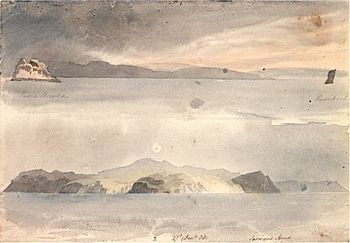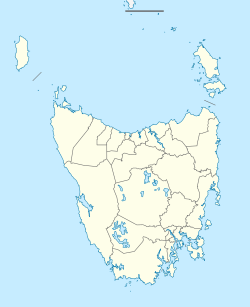Eddystone (Tasmania) facts for kids
|
Native name:
no known native connection
|
|
|---|---|

Pedra Branca and Eddistone; Tasmans Head
|
|
| Etymology | Eddystone Lighthouse in Devon, England. |
| Geography | |
| Location | Southern Ocean |
| Coordinates | 43°51′18″S 147°00′00″E / 43.85500°S 147.00000°E |
| Highest elevation | 30 m (100 ft) |
| Administration | |
|
Australia
|
|
| State | Tasmania |
| Region | Southern |
| Demographics | |
| Population | 0 |
Eddystone is a tall, tower-shaped rock or small island. It's found in the Southern Ocean, off the southern coast of Tasmania, Australia. This island is about 27 kilometers (17 miles) from South East Cape. It's part of the Southwest National Park, which is a special Tasmanian Wilderness World Heritage Site. Eddystone is 30 meters (98 feet) tall above the sea. Scientists believe it broke away from the main island of Tasmania over 15,000 years ago!
Contents
Exploring Eddystone: What Makes It Special?
Eddystone is famous for being hard to reach and for its unique shape. In 1642, explorer Abel Tasman described it as "a tall, obtuse, square tower." An old painting from 1823 shows just how close it is to Pedra Branca, which is only 2.2 kilometers (1.4 miles) to the west.
Surfing at Eddystone Rock
About 50 meters (164 feet) from Eddystone, there's a recently discovered surf break called Eddystone Rock. Local fishermen, who had known about this amazing surf spot for many years, showed it to surfers.
Wildlife on the Island
Eddystone doesn't have much plant life. However, it's an important home for many seabirds. Birds like Australasian gannets, black-faced cormorants, and fairy prions build their nests here. You might also see Australian fur seals and New Zealand fur seals resting on the lower rocks when the ocean isn't too rough.
A Special Place for Birds
Eddystone, along with nearby Pedra Branca and Sidmouth Rock, forms a 2-hectare (5-acre) area called the Pedra Branca Important Bird Area (IBA). This area is recognized by BirdLife International because it supports more than 1% of the world's population of shy albatrosses and Australasian gannets. This means it's a super important place for these birds!
How Eddystone Got Its Name
The island was named by Captain James Cook in 1777. He called it Eddystone because it looked a lot like the Eddystone Lighthouse in Devon, England.


